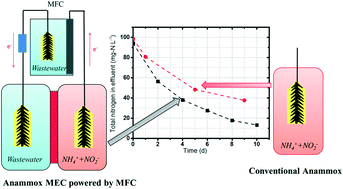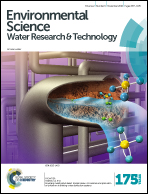Self-sustained high-rate anammox: from biological to bioelectrochemical processes
Abstract
The slow growth rate of anammox bacteria is a pressing problem for system efficiency and stability. An innovative solution was explored in this study that involves accelerating anammox in microbial electrolysis cells (MECs) and alleviating their dependence on anammox bacteria. Batch tests showed that 85% of total nitrogen (TN) was removed in the MEC system, whereas only 62% of TN was removed in conventional anammox. Simulation of the modified Nernst–Monod model revealed that the maximum specific utilization rate (0.30 to 0.38 mmol g−1 VSS h−1) in the anammox MEC was 60% higher than in conventional anammox (0.18 to 0.20 mmol g−1 VSS h−1). Harvesting the power generated in microbial fuel cells (MFCs) to support the MECs substantially saved energy consumption and effectively utilized the low power output of MFCs. Simulation of the power management system (PMS) interface demonstrated the charge/discharge cycles for power supply by the MFCs and for power consumption by the MECs. The integrated MEC-MFC system accelerated anammox, required no external carbon source, effectively utilized wastewater energy, and thus achieved self-sustained nitrogen removal.


 Please wait while we load your content...
Please wait while we load your content...